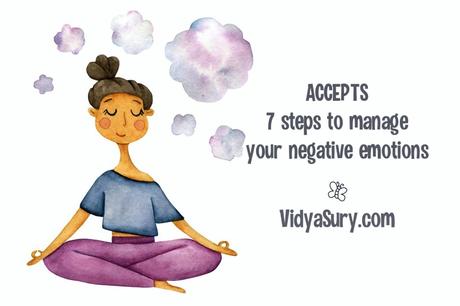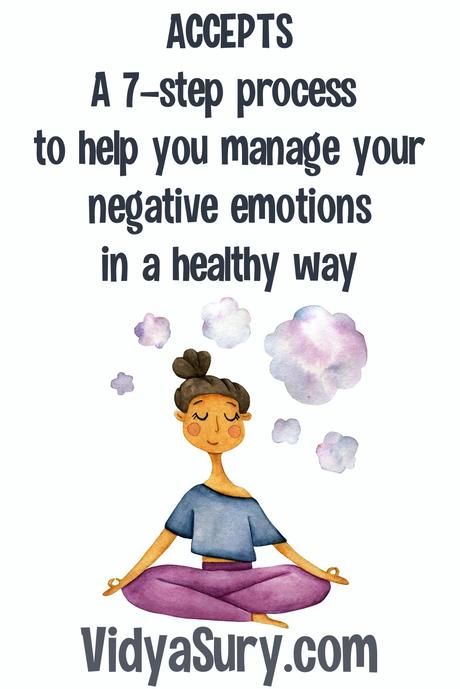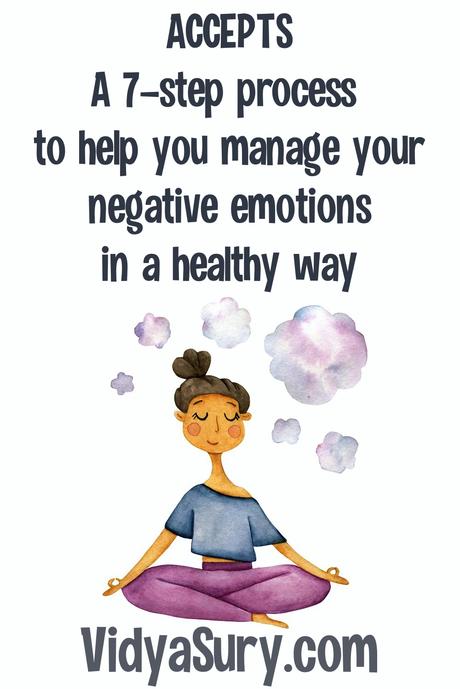
ACCEPTS is an acronym for a group of distress tolerance skills used to manage negative emotions in a healthy way until we're ready to deal with a distressing situation.
In life, it is only natural that we go through difficult times. Some of these are major - such as losing a job, the death of a loved one, breaking up with a friend, or even a divorce. Some of these are more manageable-getting stuck in traffic, an annoyingly long queue, stressing over what to wear, doing the A to Z Challenge.
How to deal with these crises?
ACCEPTS is a 7-step self-soothing process to deal with negative emotions in a healthy way so that we get into the frame of mind required to address and resolve the more intensely emotional situation.
ACCEPTS stands for Activities, Contributing, Comparisons, Emotions, Push away, Thoughts, and Sensation -offering techniques to keep our emotions manageable until we are ready to face the actual issue.
The truth is, most of us don't understand until it is too late, that the more we try to avoid a problem, the more we suffer. Ever notice smaller issues get in the way and bug the heck out of us simply because we're scared to get hurt?
When faced with distress, we tend to feel hopeless and out of control. We are desperate to make it stop. If we find it difficult to handle this, we may not be able to tolerate extreme emotions. There is research to show that this may lead to self-destructive behavior such as substance abuse, self-harm and other dangerous activities just to get temporary relief. Unfortunately, while this can act as a distraction, the relief is short-lived. It actually results in long-term suffering. What a vicious cycle!


ACCEPTS offers a way to distract from and tolerate distress in a healthy way and self-soothe. The main goal of these self-soothing skills is to prevent matters from getting worse.
If you are freaking out over the current state of the world and a lock down, you might want to try this.


How to practice ACCEPTS
This is a seven-step process and fairly simple.
Step 1: Activities
When in distress, obviously the last thing you want to do is engage in some activity. But here's the thing. When you make the choice to simply get moving and get involved in simple tasks-say housework-it can be an effective and non-destructive way to distract yourself from temporary intense distress.
Some examples of these activities
- Vacuuming
- Doing the laundry
- Organizing your closet
- Read a book/magazine
- Cook a dish
- Go for a walk/walk
- Exercise
- Call a friend
- Do the dishes
- Watch a movie
- Clean a room
- Play a game
- Do a crossword puzzle or Sudoku
Just about anything that gets you busy and takes your mind off the negative emotion until you are ready to handle it. And believe me, this works. In fact, it is a total win-win as you end up having a productive day.


Step 2: Contributing
When we are in the grip of intense emotions, we tend to be wrapped up in our own drama and become the focus of our attention. Contributing suggests shifting that focus.
This does not suggest we ignore or invalidate our own pain and distress. Instead, it redirects the self-destructive energy into something healthy and positive. When we get involved in others, it helps us regain perspective especially when we're caught in that place where we imagine that the intense distress will never end. Being of service to others makes us feel good about ourselves. It takes our mind off the problem and helps us deal with stress.
Examples of contributing
- Volunteer for a cause
- Help with cooking dinner
- Mow your neighbor's lawn
- Bake cookies for a friend
- Give someone a surprise gift
- Donate things you don't need
- Encourage someone with a compliment
- Write a thank you note
- Run errands for an elderly neighbor or relative
In short, do something thoughtful for others.


Step 3: Comparisons
Stand back to look at your current situation and compare it with something worse. If you live in a comfortable home, think about those who are homeless and struggling for food and shelter.
When we're in intense distress, it is easy to forget how much there is to be grateful for. Use this skill for a fresh perspective on what you are going through right now. Keeping a gratitude journal to list all the things you are grateful for can really help. And remember this too shall pass. It always does.
Some comparisons you can practice
- Compare how you are feeling now to a time when you felt different
- Reflect on people coping the same as you or less well than you
- Compare yourself to those who are not as fortunate
- Reflect on the current state of the world. You are probably better off than you imagine.


Step 4: Emotions
When we do something opposite to our emotional state, it can act as a powerful tool to disperse overwhelming emotions. We shift in and out of emotional states. A dose of the opposite emotion will reduce the intensity of the negative emotion. It can help shift the current state of mind and also remind you that this present state is temporary.
Some examples to practice opposite emotions
- Tired and lethargic? Go for a walk around the block
- Sad? Watch a funny movie
- Bored? Dance it out
- Anxious? Practice meditation
- Down? Google adorable puppies
- Nervous? Listen to soothing music.
In short do something that makes you feel the opposite of what you are feeling now.


Step 5: Pushing Away
When you are unable to deal something at this moment, it is okay to push it away from your mind for the time being. Push it away by distracting yourself with other thoughts or activities. I find it helpful to set myself a time frame to return to the actual issue at hand. It might help you relax while you wait.
Some ways to practice pushing away
- Feel powerless right now? visualize yourself as strong and powerful.
- Feel angry with someone? Imagine them shrinking away.
- Visualize writing your problem on a paper, crumpling it and throwing it away
- Box your pain and put it on the highest shelf for a while
- Build a wall between you and the problem.
Again, do remember that we are not denying your current emotions. We are just transforming them until you are ready to process them.


Step 6: Thoughts
When we go through unbearable and overpowering emotions, we are controlled by the "emotion mind." Until we shift to a "wise mind", we must use the "reasonable mind" to help us move out of our intense emotional state. So, replace negative thoughts with activities to keep your mind busy.
Here is what you can do to create that internal shift
- Start reading a book and focus on it 100%
- Stay the alphabet backwards
- Do a puzzle
- Count to 10
- Recite a poem
- Look at a painting and count the colors
- Recite the lyrics of a song in your mind
- Watch TV


Step 7: Sensations
Physical sensations can be a powerful distraction from intense negative feelings. This is why some people who are unable to manage their emotional states end up harming themselves. Instead, use the distracting power of physical sensations to your benefit. Use your senses to self-soothe when you are distressed.
Some sensations to practice
- Take a warm bath with scented bath bombs and music
- Eat a comforting snack
- Watch your favorite show
- Hold ice cubes in your hands
- Inhale your favorite perfume
- Squeeze a rubber ball
- Listen to loud music
In fact, anything that calms you, invokes pleasant physical feelings and helps you cope or snaps you out of your current state.


A tip to use the ACCEPTS technique effectively
Wondering how to use the ACCEPTS technique and remember what to do? Here's a tip. Be prepared in advance to deal with intense emotions when they appear. Make small note-cards with the strategies listed on them so you can refer to them to self-soothe. As simple as that.
How do you deal with intense negative feelings?
Have you tried ACCEPTS?
♥
Wednesday Wisdom is a series with short bursts of easy-to-consume wisdom in the form of inspiring stories, verse, quotes, anecdotes, reflections, easy meditation, thought-provoking questions and humor.♥
April A to Z Challenge: A for ACCEPTS DBT skills technique
